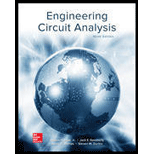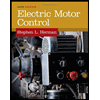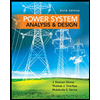
Engineering Circuit Analysis
9th Edition
ISBN: 9780073545516
Author: Hayt, William H. (william Hart), Jr, Kemmerly, Jack E. (jack Ellsworth), Durbin, Steven M.
Publisher: Mcgraw-hill Education,
expand_more
expand_more
format_list_bulleted
Question
Chapter 11, Problem 62E
To determine
Find the value of load impedance in the circuit in Figure 11.52 in the textbook in order to transfer maximum power to the load.
Expert Solution & Answer
Want to see the full answer?
Check out a sample textbook solution
Students have asked these similar questions
Please describe how to do each step in detail. thanks
2. For the OPAMP below:
g) Grounding the inputs, perform a DC analysis (assume beta is infinite and VBE=0.7V and neglect the early voltage),calculate the DC currents and voltages everywhere in the circuit (all the collector and emitter currents and voltages aswell as the output voltage). Note that Q4 is 4 times as big as Q9 and Q3h) If Q1 and Q2 have a beta of 100, calculate the input bias current to the opampi) What is the input common mode range of this opamp?j) Calculate the common mode gain if the early voltage of Q3 and Q6 is 50Vk) Calculate the differential gain vo/vid of this circuitI) Calculate the input and output impedance of the opamp assuming beta is 100m) Calculate the input referred offset (Vos) if R2=21K
1. For the difference amplifier below, R1=R3=10K, R2=R4=50k, assume opamp is ideala) Find the differential mode gain, Admb) Find the input impedance (differential, between wi and va)c) Find the common mode gain in the presence of resistor mismatch (If R3=R1+ deltaR1, R4=R2+ deltaR2, deltaR1=100, deltaR2=500)d) Find the common mode rejection ratio (CMRR)e) Find the input impedance and output impedancef) If the OPAMP has an input current of 100uA, find the output offset voltage, set Vi1 = Vi2=0V
Chapter 11 Solutions
Engineering Circuit Analysis
Ch. 11.1 - A current source of 12 cos 2000t A, a 200 ....Ch. 11.2 - Given the phasor voltage across an impedance ,...Ch. 11.2 - Prob. 3PCh. 11.2 - Prob. 4PCh. 11.2 - A voltage source vs is connected across a 4...Ch. 11.3 - If the 30 mH inductor of Example 11.7 is replaced...Ch. 11.4 - Calculate the effective value of each of the...Ch. 11.5 - For the circuit of Fig. 11.16, determine the power...Ch. 11.6 - Prob. 10PCh. 11 - Prob. 1E
Ch. 11 - Determine the power absorbed at t = 1.5 ms by each...Ch. 11 - Calculate the power absorbed at t = 0, t = 0+, and...Ch. 11 - Three elements are connected in parallel: a 1 k...Ch. 11 - Let is = 4u(t) A in the circuit of Fig. 11.28. (a)...Ch. 11 - Prob. 6ECh. 11 - Assuming no transients are present, calculate the...Ch. 11 - Prob. 8ECh. 11 - Prob. 9ECh. 11 - Prob. 10ECh. 11 - The phasor current I=915mA (corresponding to a...Ch. 11 - A phasor voltage V=10045V (the sinusoid operates...Ch. 11 - Prob. 13ECh. 11 - Prob. 14ECh. 11 - Find the average power for each element in the...Ch. 11 - (a) Calculate the average power absorbed by each...Ch. 11 - Prob. 17ECh. 11 - Prob. 18ECh. 11 - Prob. 19ECh. 11 - The circuit in Fig. 11.36 has a series resistance...Ch. 11 - Prob. 21ECh. 11 - Prob. 22ECh. 11 - Prob. 23ECh. 11 - Prob. 24ECh. 11 - Prob. 25ECh. 11 - Prob. 26ECh. 11 - Prob. 27ECh. 11 - Prob. 28ECh. 11 - Prob. 29ECh. 11 - Prob. 30ECh. 11 - Prob. 31ECh. 11 - Prob. 32ECh. 11 - Prob. 33ECh. 11 - (a) Calculate both the average and rms values of...Ch. 11 - Prob. 35ECh. 11 - FIGURE 11.43 Calculate the power factor of the...Ch. 11 - Prob. 37ECh. 11 - Prob. 38ECh. 11 - Prob. 40ECh. 11 - Prob. 41ECh. 11 - Prob. 42ECh. 11 - Prob. 43ECh. 11 - Compute the complex power S (in polar form) drawn...Ch. 11 - Calculate the apparent power, power factor, and...Ch. 11 - Prob. 46ECh. 11 - Prob. 48ECh. 11 - Prob. 49ECh. 11 - Prob. 50ECh. 11 - Prob. 51ECh. 11 - Prob. 52ECh. 11 - FIGURE 11.49 Instead of including a capacitor as...Ch. 11 - Prob. 54ECh. 11 - A load is drawing 10 A rms when connected to a...Ch. 11 - For the circuit of Fig. 11.50, assume the source...Ch. 11 - Prob. 57ECh. 11 - A source 45 sin 32t V is connected in series with...Ch. 11 - Prob. 60ECh. 11 - FIGURE 11.51 The circuit in Fig. 11.51 uses a Pi...Ch. 11 - Prob. 62ECh. 11 - Prob. 63ECh. 11 - You would like to maximize power transfer to a 50 ...
Knowledge Booster
Similar questions
- For the circuit shown, I-20 mA, R₁ =10000 2, R2 =2000 Q, R3 -2000 Q, R₁-6000 2, Vcc 5 V and the OPAMP is ideal with regions of operation are considered. The output current lo in mA is (choose the closet value): R₂ Is R₁ W VCC -VCC The relative tolerance for this problem is 1 %. -0.458 -0.833 6.667 -6.667 ○ 0.458 0.833 w R3 w RLarrow_forwardFor the circuit shown, let R₁-4, R2-50, R3-2, R4-77 and Vin-18. Find the current I₁ and voltage Vo as follows: Use op-amp building blocks to determine the voltage Vo1: V01 = Then use Vo1 to find the current 11: 1₁ = Find the voltage Vo: Vo= R1 www Vin R₂ ww V01 R3 The relative tolerance for this problem is 9 %. + R4 www +5°arrow_forwardFor the circuit shown, let Vs1 = 13, Vs2 = 7 R1-10, R2= 50, assume ideal-op-amp, and find • The current Is • The output voltage Vo= VSI A S R₁ ww 1 R₂ www V₁₂ + Varrow_forward
- For the circuit shown, let R₁ =16 Q, R₂ =48 2, R3 = 28 2, R4 =84 02, R5 -2002, R6 -80 2, and V₁ =4 mV. Assume ideal op-amp, find (round your answer to three digits) : Va= (MV) Vb = (MV) (mA) Vout = (MV) R₁ R₂ V₁ + R3 Vb W The relative tolerance for this problem is 7 %. ww R4 24 R5 55 R6 VOUTarrow_forwardFor the circuit shown, find the voltage Vo and current l。. Let R₁=8, R2=1, R3-11 and V₂-3. V S (+1 || w R₂ R1 + R3 Vo The voltage Vo is: The current lo is: The relative tolerance for this problem is 3 %.arrow_forwardFor the circuit shown, find currents 11, 12, 13, and the voltage Vo. Assume ideal op-amp, and let R₁=3, R2-40, Ro=85 and 1-6 The current I₁ is: The current 12 is: The current 13 is: The voltage Vo is: R₂ w R₁ 13 w Roarrow_forward
- For the circuit shown, let v₂ = 9, R₁=86, R2= 15, R3 =7, assume ideal-op-amp, and find • The current l₂ = • Voltage gain, Av= Vo/Vs= • The output voltage vo = A US 1+ 1. R₁ R₂ R3 10 +arrow_forwardFor the op-amp circuit shown, find the voltage Vo, and the current lo. Let R₁=8, R2=58, R3-27 and V₂-101. R1 + R₂ ww + V + The voltage Vo The current lo = = The relative tolerance for this problem is 3 % R3arrow_forwardThe circuit shown in Fig. 14.98 has the impedance Z(s) = 1,000(s+1) (s+1+j50)(s+1 – j50) ' s=j@ Find: (a) the values of R, L, C, and G (b) the element values that will raise the resonant frequency by a factor of 103 by frequency scaling Z(s) Figure 14.98 For Prob. 14.81. R 7arrow_forward
- Chapter 14, Problem 57. Determine the center frequency and bandwidth of the bandpass filters in Fig. 14.88. 1 F ΙΩ ww V. (+ 1 F 10 V 1 H m (a) (b) ΙΩ ww ΙΩ 1HV Figure 14.88 For Prob. 14.57.arrow_forwardChapter 14, Problem 43. Calculate the resonant frequency of each of the circuits in Fig. 14.82. C (a) Figure 14.82 For Prob. 14.43. (b) C Larrow_forwardChapter 14, Problem 69. end Design the filter in Fig. 14.94 to meet the following requirements: (a) It must attenuate a signal at 2 kHz by 3 dB compared with its value at 10 MHz. (b) It must provide a steady-state output of v。 (t) input v, (t)=4sin(2 × 108t) V. = 10 sin(2x 108t+ 180°) V for an Rf ww R ww C 1+ Vs Figure 14.94 For Prob. 14.69.arrow_forward
arrow_back_ios
SEE MORE QUESTIONS
arrow_forward_ios
Recommended textbooks for you

 Power System Analysis and Design (MindTap Course ...Electrical EngineeringISBN:9781305632134Author:J. Duncan Glover, Thomas Overbye, Mulukutla S. SarmaPublisher:Cengage Learning
Power System Analysis and Design (MindTap Course ...Electrical EngineeringISBN:9781305632134Author:J. Duncan Glover, Thomas Overbye, Mulukutla S. SarmaPublisher:Cengage Learning


Power System Analysis and Design (MindTap Course ...
Electrical Engineering
ISBN:9781305632134
Author:J. Duncan Glover, Thomas Overbye, Mulukutla S. Sarma
Publisher:Cengage Learning